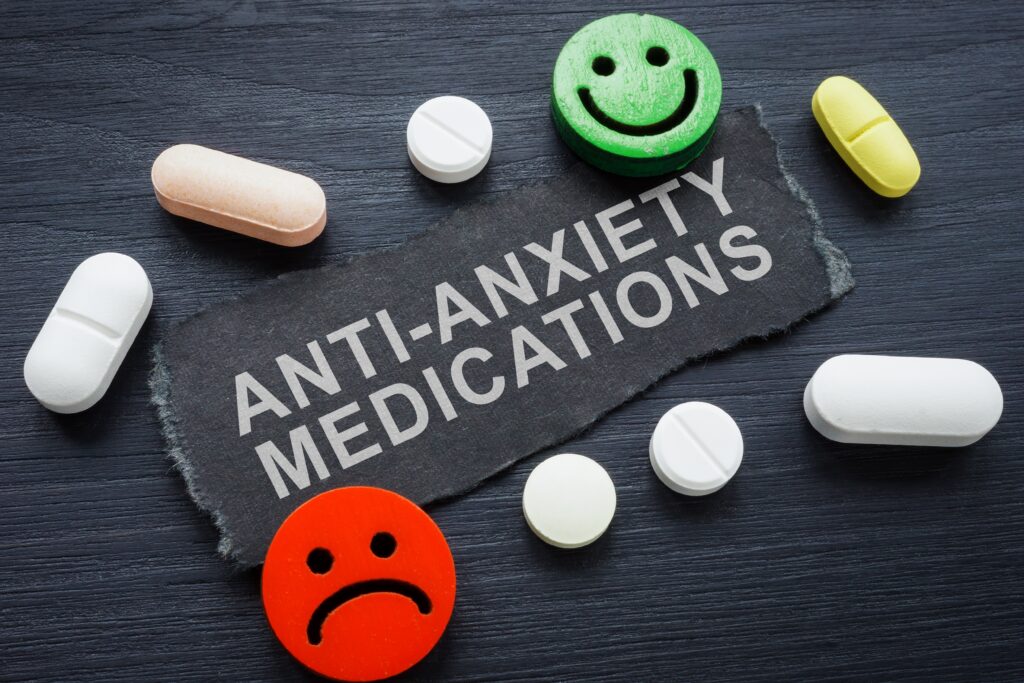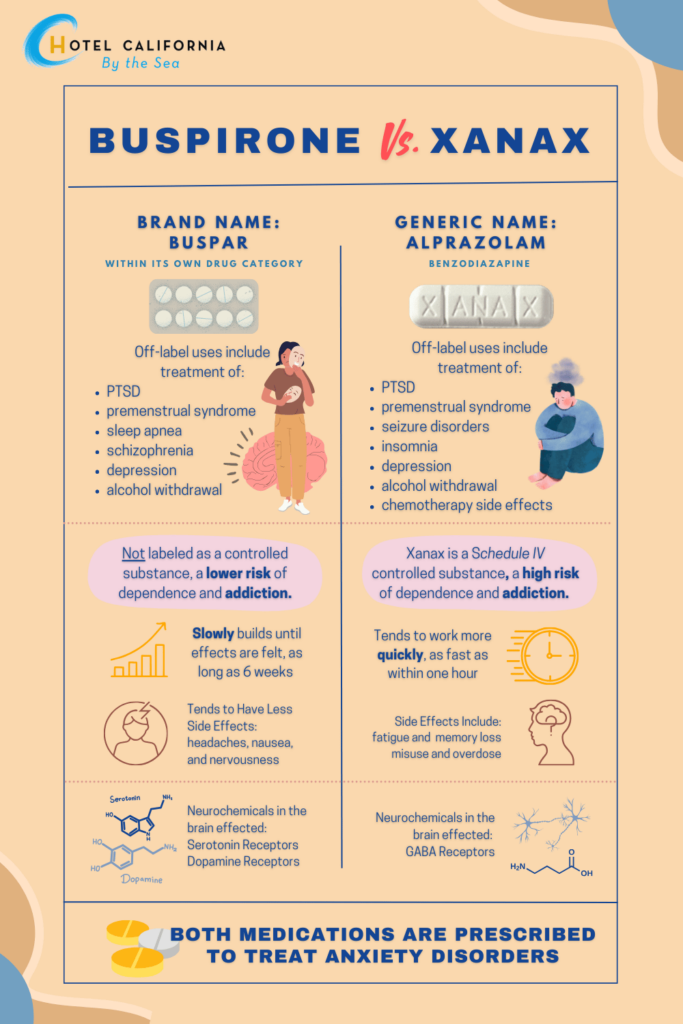Buspirone vs Xanax
Buspirone and Xanax are both medications prescribed to treat anxiety disorders. Both are very effective, but are very different types of drugs. What is the difference between buspirone vs Xanax? Buspirone, also known by its brand name Buspar, is an anxiolytic that can be used for both long-term and short-term treatment. While Xanax, also known by its generic name alprazolam, is a benzodiazepine and is usually only prescribed for short-term treatment.

Anxiety disorder impacts more than an estimated 30% of adults in the US. It is the most common form of mental illness in the country. Anxiety is a normal reaction to feelings of stress. However, when these feelings of nervousness, anxiousness and stress involve excessive and constant fear, it can turn into a disorder. Generalized anxiety disorder is characterized by persistent and excessive worry that interferes with daily life activities.
There are many types of anxiety disorders: generalized anxiety disorder, agoraphobia, social anxiety, separation anxiety, selective mutism and panic disorder. Fortunately, anxiety disorders are very treatable with behavioral therapy and medication-assisted treatments.
Both buspirone and Xanax are popular drugs used to treat symptoms of anxiety and other related conditions such as panic attacks and depression. These two anti-anxiety prescription medications differ in the way they treat the mental illness. They also have differing side effects that can cause a potential for dependency.

Buspirone vs Xanax
Buspirone
- Brand name Buspar.
- Works by binding to serotonin and dopamine receptors with similar effects as SSRI medications. These neurotransmitters play an important role in regulating anxiety symptoms.
- Anxiolytic medication that was originally created as an antipsychotic medication. However, researchers found it was more effective at relieving symptoms of anxiety rather than symptoms of psychosis.
- The average duration of treatment takes 2 weeks for medication to go into effect and is prescribed for both short-term and long-term treatment plans.
- Provides gradual and continuous symptom improvement.
- Off-label uses include treatment of PTSD, premenstrual syndrome, sleep apnea, schizophrenia, depression and alcohol withdrawal.
- The average cost of 30 tablets at 15mg is $12.
- The average dose starts at 7.5mg twice daily and can be increased every 2-3 days in increments of 5mg. The total dosage should not exceed 60mg.
- Side effects: dizziness, nausea, headache, blurred vision, nervousness, dry mouth, restlessness, insomnia, diarrhea, muscle weakness, tingling sensation in hands and feet and confusion
- Severe side effects: depression, hostility, seizures, uncontrolled movements, withdrawal symptoms and suicidal thoughts and behaviors.
- Negative interactions: MAOIs, SSRIs, SNRIs and grapefruit juice.
Xanax
- Generic name alprazolam.
- Works by impacting the central nervous system, binding to the GABA receptors in the brain to block the transmission of nerve impulses. This depresses the central nervous system and increases feelings of sedation and muscle relaxation. This helps reduce feelings of anxiety.
- This benzodiazepine medication is FDA-approved to treat conditions such as generalized anxiety disorder and panic disorder.
- The effects of the medication can be felt within an hour after consumption. It starts working within the first week of treatment. It is prescribed for short-term treatment only.
- Provides fast and quick relief.
- Off-label uses include: insomnia, chemotherapy side effects, PTSD, premenstrual syndrome, alcohol withdrawal, depression and seizure disorders.
- The average cost of 100 tablets at 0.25mg is $520.
- Oral tablets come in dosages of 0.25mg, 0.5mg, 1mg and 2mg. The average dose of Xanax should not exceed 4mg per day.
- Side effects: fatigue, drowsiness, changes in weight and appetite, memory impairment, dizziness, lightheadedness, nausea, diarrhea, constipation, slurred speech, muscle weakness and swelling of hands and feet.
- Severe side effects: swelling under the skin, rapid heart rate, liver damage, low blood pressure, respiratory depression, seizures, Stevens-Johnson syndrome, withdrawal symptoms, sedation, hallucination, aggression, substance abuse and addiction, coma and death.
- Negative interactions: opioids, alcohol and other substances that cause sedation and drowsiness.
Check Your Insurance Coverage for FREE
Find out if your insurance covers addiction treatment in minutes. We accept most insurance!
One of the main differences between buspirone and Xanax is that one is a controlled substance, while the other is not and carries less of a risk for dependence. Xanax is a Schedule IV controlled substance with a high risk for dependence and addiction. Buspirone has a much lower risk of drug dependence and addiction.
Both anti-anxiety medications also carry different mechanisms of action when it comes to treating the mental health disorder. Buspirone affects serotonin and dopamine neurochemicals in the brain. Xanax affects GABA chemicals in the brain.
Xanax tends to work more quickly and is often approved for short-term use and provides immediate relief of symptoms. It can work as fast as within an hour after drug administration. Buspirone begins at a low dosage, allowing the body to slowly adjust to the medication, and then slowly builds up until the effects are felt. This allows for a constant projection of symptom relief over a longer period of time. But this means it can take as long as 6 weeks for the effects of the drug to be fully achieved.
Some studies have shown that people taking Xanax experience more side effects of fatigue, insomnia and drowsiness. Those who are taking buspirone experience many fewer side effects. This may be a deciding factor in which type of anti-anxiety medication is best for your needs.
Studies have found that both medications are very efficient in treating symptoms of anxiety. Patients on Xanax showed quicker signs of improvement, while patients on buspirone showed steady and continuous improvement.
Reach out to Hotel California by the Sea
We specialize in treating addiction and other co-occurring disorders, such as PTSD. Our Admissions specialists are available to walk you through the best options for treating your addiction.
Treatment for Substance Use Disorder
Buspirone and Xanax are popular anti-anxiety medications that are very effective in treating symptoms of the disorder. Buspirone falls under its own drug category and Xanax is considered to be a benzodiazepine. Though they work using different mechanisms of action, both fall under the category of treating generalized anxiety disorder.
Both prescription medications can lead to dependence on the drug and the development of an addiction. However, Xanax can put you at a higher risk compared to buspirone. Behavioral health treatment programs such as Hotel California by the Sea provide dedicated care and commitment to helping people with substance use disorders.
We offer treatment at all levels of care including detox, residential, PHP and IOP. We utilize evidence-proven methods such as CBT, DBT, group therapy and family therapy. Hotel California by the Sea is dedicated to helping our clients achieve their goals of sobriety and overcome their addiction.
References:
https://khealth.com/learn/medication/buspirone-vs-xanax
https://www.verywellhealth.com/buspirone-vs-xanax-alprazolam-7498006
https://www.drugrehab.com/addiction/prescription-drugs/xanax/xanax-vs-buspirone
https://www.choosingtherapy.com/buspirone-vs-xanax
https://www.goodrx.com/health-topic/anxiety-disorders/buspirone-vs-xanax
https://ro.co/health-guide/buspirone-vs-xanax
https://www.psychiatry.org/patients-families/anxiety-disorders/what-are-anxiety-disorders
